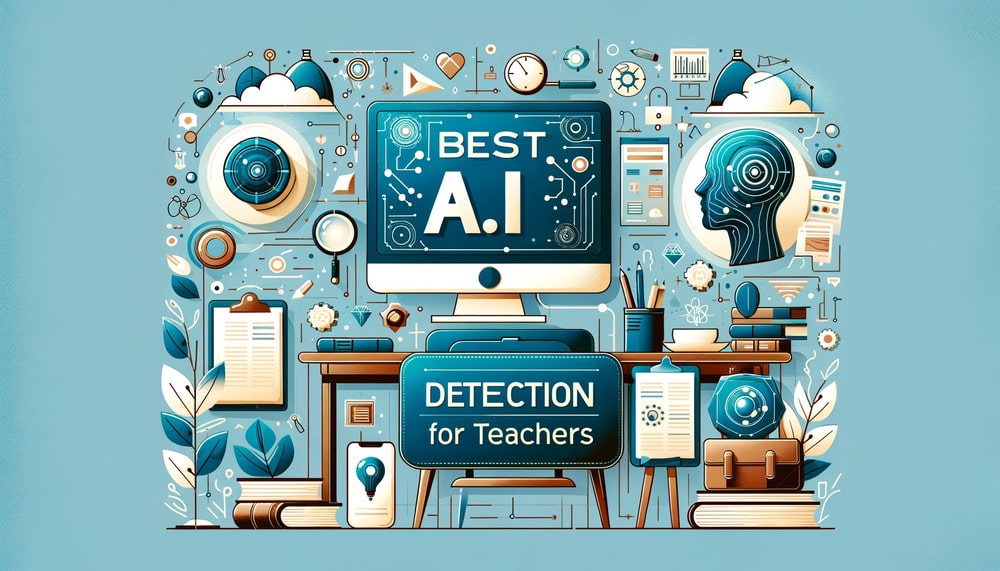Importance of AI Detection in Education
As AI-generated content becomes increasingly sophisticated, the need for effective AI detection in educational settings has never been more critical. The rise of AI tools capable of generating human-like text poses significant challenges to academic integrity. Ensuring that students’ work is original and genuinely reflective of their understanding is paramount for maintaining the credibility of educational institutions.
Why AI Detection is Essential for Teachers
AI-generated content is now prevalent across various fields, including education. Tools like ChatGPT can produce essays, research papers, and other assignments that are difficult to distinguish from human-written work. This prevalence makes it essential for teachers to have robust AI detection tools at their disposal to uphold academic honesty.
Explanation of AI-Generated Content and Its Prevalence
AI-generated content refers to text created by artificial intelligence algorithms designed to mimic human writing. These tools are widely accessible and can be used to generate entire documents with minimal human intervention. The ease of access and the quality of the generated content have led to a significant increase in its use by students.
Importance of Maintaining Academic Honesty
Maintaining academic honesty is crucial for fostering a learning environment where students are evaluated based on their true understanding and skills. AI-generated content undermines this by allowing students to submit work that is not their own, thus compromising the integrity of their education and devaluing the efforts of their peers.
Challenges Faced by Teachers in Identifying AI-Written Work
Identifying AI-written work poses several challenges for educators. AI-generated texts are often well-written and coherent, making them difficult to distinguish from student-authored content. Moreover, the rapid advancements in AI technology mean that detection tools must continuously evolve to keep up with new capabilities. This dynamic environment requires teachers to stay informed and equipped with the latest tools to effectively identify and address AI-generated content in student work.
By understanding these challenges and leveraging advanced AI detection tools like GPTZero, Copyleaks, QuillBot, Content at Scale, and Crossplag, educators can better uphold academic integrity and ensure a fair evaluation of student performance.

Best AI Detection for Teachers
GPTZero
Overview: GPTZero is a sophisticated AI detection tool tailored for educators to identify AI-generated content in student submissions. Developed by a Princeton University student, this tool employs metrics such as perplexity and burstiness to differentiate between human and AI writing.
Key Features:
- Detection Capabilities: GPTZero can detect AI-generated text at the sentence, paragraph, and document levels. It supports various AI models, including ChatGPT, GPT-4, BARD, and LLaMA (InBound Blogging) (GPTZero).
- User Interface: The tool offers a straightforward interface with detailed explanations of results, enhancing user understanding and usability (GPTZero).
- Multilingual Support: GPTZero supports multiple languages, making it versatile for diverse educational settings (GPTZero).
- Accessibility: It includes a free version for basic usage and paid plans for more extensive needs. The free version allows for checking shorter texts, while the paid plans provide higher character limits and additional features (InBound Blogging) (GPTZero).
Usage in Education: Teachers can integrate GPTZero into their workflows by using its web interface or Chrome extension. The tool’s detailed reports help educators understand the extent of AI usage in student work, fostering informed discussions on academic integrity (GPTZero).
Effectiveness:
- Accuracy: GPTZero is generally accurate in detecting AI-generated content, though its effectiveness can vary with newer AI models and mixed texts. It is especially useful for identifying AI-written sections in larger documents (InBound Blogging) (GPTZero).
- Challenges: Users have noted occasional false positives, where human-written content is incorrectly flagged as AI-generated. Continuous updates and fine-tuning are required to improve its accuracy (InBound Blogging) (AcademicHelp.net).
Copyleaks
Overview: Copyleaks is a comprehensive AI detection and plagiarism-checking tool designed for educational and professional environments. It uses advanced machine learning algorithms to detect AI-generated content, direct plagiarism, and paraphrased variations.
Key Features:
- Detection Capabilities: Copyleaks can analyze content from various sources, including uploaded files, copy-pasted text, URLs, and code files. It uses Optical Character Recognition (OCR) to process different formats and generate detailed content detection reports (Niche Pursuits) (Appscribed).
- User Interface: The platform offers an intuitive dashboard where users can manage scans, view past results, and adjust detection settings. It supports single sign-on for enterprise accounts, enhancing accessibility and ease of use (Yahoo).
- Language Support: Copyleaks supports multiple languages, making it suitable for global educational institutions (Appscribed).
- Integration: The tool integrates seamlessly with Learning Management Systems (LMS) and offers customizable API options for tailored detection solutions (Niche Pursuits) (Appscribed).
Usage in Education: Educators can use Copyleaks to ensure the originality of student work by detecting AI-generated and plagiarized content. The tool’s ability to handle multiple file formats and provide comprehensive reports makes it an essential resource for maintaining academic integrity (Yahoo).
Effectiveness:
- Accuracy: Copyleaks is effective at detecting both AI-generated and plagiarized content. Its detailed reports highlight the sources of detected content, aiding in thorough verification (Niche Pursuits) (Appscribed).
- Challenges: Some users have reported performance issues, such as lag during analysis and occasional false positives. Additionally, the credit-based pricing model and subscription management have received mixed feedback (TheAirports) (Appscribed).
Conclusion: Both GPTZero and Copyleaks offer valuable tools for educators to detect AI-generated and plagiarized content, each with its own strengths and challenges. GPTZero excels in detailed AI detection at various content levels, while Copyleaks provides a comprehensive solution with robust plagiarism detection and multi-format support. Educators can choose the tool that best fits their specific needs and institutional requirements.
QuillBot
Overview: QuillBot is a versatile AI detection tool that also functions as a writing assistant, offering features such as paraphrasing, summarizing, and grammar checking. It provides high accuracy in detecting AI-generated content, making it a valuable resource for educators.
Key Features:
- AI Detection: QuillBot can detect AI-generated content with significant accuracy. It provides a percentage likelihood that the content is AI-generated, helping users make informed decisions about the authenticity of the text (Scribbr) (Appscribed).
- User Interface: The platform is user-friendly, allowing easy navigation and quick checks. Users can paste text or upload files for analysis without needing to sign up (Scribbr).
- Writing Assistance: In addition to AI detection, QuillBot offers grammar checking, paraphrasing, and summarizing tools, making it a comprehensive solution for improving and verifying content quality (Appscribed).
Usage in Education: Educators can use QuillBot to verify the originality of student submissions by detecting AI-generated content. Its additional features, like grammar checking and paraphrasing, can also aid students in improving their writing skills (Scribbr).
Effectiveness:
- Accuracy: QuillBot is highly effective at detecting AI-generated content, including texts modified by paraphrasing tools. It provides clear, percentage-based results, which are easy to interpret (Scribbr) (Appscribed).
- Challenges: While QuillBot is generally accurate, it may not always highlight specific AI-generated sections within the text. Users should combine its results with other verification methods for best results (Appscribed).
Content at Scale
Overview: Content at Scale is an AI detection tool that leverages natural language processing (NLP) models to identify AI-generated content. It is designed to handle large texts efficiently, making it suitable for extensive documents like essays and articles.
Key Features:
- Detection Capabilities: Content at Scale uses advanced NLP models to detect AI-generated content. It can analyze large texts, providing a human content score that indicates the likelihood of the text being human-written or AI-generated (Homepage – Educators Technology) (Appscribed).
- User Interface: The tool offers a straightforward interface where users can paste or upload content for analysis. It provides quick and clear results, making it easy to use for educators and other professionals (Homepage – Educators Technology).
- Scalability: Designed to handle large volumes of text, Content at Scale is ideal for analyzing lengthy documents, ensuring thorough detection without compromising on speed (Homepage – Educators Technology) (Appscribed).
Usage in Education: Educators can use Content at Scale to verify the originality of extensive student submissions, such as research papers or dissertations. Its ability to process large texts quickly makes it a practical choice for academic settings (Homepage – Educators Technology) (Appscribed).
Effectiveness:
- Accuracy: Content at Scale is effective in identifying AI-generated content, providing clear scores that indicate the likelihood of AI involvement. This helps educators make informed decisions about the authenticity of student work (Homepage – Educators Technology).
- Challenges: While generally reliable, the tool’s effectiveness can vary with different text types and complexities. It may also lack specific features like highlighting AI-generated sections within the text (Homepage – Educators Technology).
Crossplag
Overview: Crossplag is a holistic AI detection and plagiarism checking tool that uses machine learning and language processing techniques to evaluate the originality of content. It is designed to support multiple languages and offers detailed confidence scores for each scan.
Key Features:
- Detection Capabilities: Crossplag can detect AI-generated content and direct plagiarism by comparing the submitted text against a vast database of online sources. It provides detailed confidence scores, indicating the likelihood of AI generation (College Transitions) (Appscribed).
- User Interface: The tool features a user-friendly interface that allows users to paste or upload content for analysis. It also supports multiple file formats, making it versatile and easy to use (Appscribed).
- Language Support: Crossplag supports multiple languages, making it suitable for use in diverse educational and professional environments (College Transitions) (Homepage – Educators Technology).
Usage in Education: Educators can use Crossplag to ensure the originality of student submissions by detecting AI-generated content and plagiarism. Its detailed confidence scores help educators understand the extent of potential issues and take appropriate action (College Transitions) (Homepage – Educators Technology).
Effectiveness:
- Accuracy: Crossplag is effective at identifying both AI-generated content and plagiarism. Its confidence scores provide a clear indication of the likelihood of AI involvement, aiding in thorough verification (College Transitions) (Homepage – Educators Technology).
- Challenges: Some users have reported occasional false positives, where human-written content is incorrectly flagged. Continuous updates and fine-tuning are necessary to improve accuracy (College Transitions) (Appscribed).
- Conclusion: QuillBot, Content at Scale, and Crossplag each offer unique strengths for educators seeking to detect AI-generated content and maintain academic integrity. QuillBot excels with its additional writing assistance features, Content at Scale is ideal for analyzing large texts, and Crossplag provides detailed confidence scores and multi-language support. Educators should choose the tool that best fits their specific needs and context.
Conclusion
In an era where AI-generated content is becoming increasingly prevalent, ensuring the authenticity of student work is paramount. Each of the AI detection tools discussed—GPTZero, Copyleaks, QuillBot, Content at Scale, and Crossplag—offers unique features and capabilities that make them valuable assets for educators.
- GPTZero stands out for its detailed analysis at the sentence, paragraph, and document levels, supporting multiple AI models. Its straightforward interface and multilingual support make it a robust choice for educators aiming to detect AI-generated content in student submissions (InBound Blogging) (GPTZero).
- Copyleaks provides a comprehensive solution for both AI detection and plagiarism checking. Its ability to handle multiple file formats and languages, combined with a user-friendly interface, makes it versatile for various educational settings (Niche Pursuits) (Appscribed).
- QuillBot offers high accuracy in detecting AI-generated content along with additional features like grammar checking and paraphrasing. Its ease of use and clear, percentage-based results make it an effective tool for enhancing and verifying content quality (Scribbr) (Appscribed).
- Content at Scale excels in analyzing large texts efficiently, providing clear human content scores. Its straightforward interface and scalability make it ideal for academic settings where extensive documents need to be evaluated (Homepage – Educators Technology) (Appscribed).
- Crossplag combines AI detection with robust plagiarism checking, offering detailed confidence scores and multi-language support. Its user-friendly interface and ability to handle various content types make it a comprehensive tool for ensuring content originality (College Transitions) (Homepage – Educators Technology).
Each tool has its strengths and challenges, but collectively, they provide a range of options for educators to maintain academic integrity. By selecting the tool that best fits their specific needs, educators can effectively combat the rise of AI-generated content and uphold the standards of authentic, original work in their classrooms.


